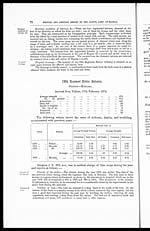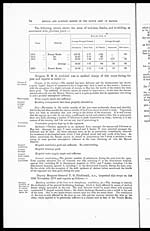Medicine - Institutions > Army health reports and medical documents > Medical and sanitary reports of the native army of Madras > Medical and sanitary report of the native army of Madras for the year 1876
(82) Page 73
Download files
Individual page:
Thumbnail gallery: Grid view | List view

MYSORE DIVISION.
73
Drainage of
the men's
huts, &c.
Drainage of the men's huts, &c. —The drainage is very imperfect, there not being a pucka-
made drain throughout the whole lines; drainage is carried on by small trenches dug in the
superficial earth, which are torn into holes in the monsoon and become cess-pools from soakage
of sewage matter in the dry weather; this has been reported on by different Medical Officers, but
so far no improvement has taken place, I believe, on account of the expenditure which would be
necessarily incurred in building good drains.
Water-
supply.
Water-supply. —Good quality and abundant.
Sanitary
arrange-
ments.
Sanitary arrangements satisfactory. The sanitation of the lines will never be even fairly
good until good brick and chunam drains are put up and the basin beneath the lines drained.
Diet.
Diet. —Provisions of all sorts are very dear in this station; vegetables are also scarce and
dear; the only compensation the sepoy gets is the regulation rice allowance, which is quite
insufficient. Any sepoy with a large family is quite unable to supply himself with sufficient
nourishment out of his pay. I believe a great deal of the sickness in the regiment is produced
by eating cheap and unsound food.
Foot
soreness.
Foot soreness has been rather prevalent during the year, or at least during the parade
months. Men suffering from slight sores were excused boats for a few days; sores of a more
serious character were treated in hospital.
Vaccination.
Vaccination was carried out amongst the children, but no sepoys were vaccinated during
the year.
Hospital
ventilation.
Hospital ventilation satisfactory. No overcrowding during the year.
Hospital drainage.
Hospital drainage satisfactory.
General
conclusions.
General conclusions.— The health of the regiment is considerably improved during the year;
the men are becoming to a great extent acclimatized.
Deputy Surgeon-General P. G. FitzGerald, M.D., inspected this corps on the
21st November 1876 and. reports as follows:—
Sanitary
condition of
the lines.
Sanitary condition of the lines. —The lines of the 28th Regiment Native Infantry are
situated on the north and east sides of a crater-like hollow to the south of the fort, the left being
on the east and the right on the north side. This hollow deepens gradually from its southern to
its northern extremity. The outlet for its drainage is at the north-west corner, where a wide
gorge connects it with a more open valley to the westward. Unfortunately the regiment has not
the whole of this hollow to itself. A dirty Gowlie village occupies the west side of it, and is not
more than a stone's throw from the nearest sepoy's hut. This village has been frequently
reported as a nuisance and a danger, and it has been shown that 3,000 Rupees would buy it all
up. Its huts are irregularly built, without plan or order, and defy all attempts at conservancy
or drainage. Besides its human inhabitants it shelters at night an equal or greater number of
buffaloes.
Water-
supply
Water-supply is very good.
Conservancy.
Conservancy.— The glacis of the fort all round requires a good deal of attention. There are
irregularities of surface which tempt people to commit nuisance, and this is especially the case
on its west side near the unfinished latrine.
Hospital.
Hospital. —The latrines are on the dry-earth system, with long instead of short troughs;
they are kept quite clean.
30th Regiment Native Infantry.
STATION—FRENCH ROCKS.
Arrived from Thayetmyo, 11th February and 20th March 1869.
| Average strength | 754 |
| Do. do. present | 628 |
| Admissions | 333 |
| Daily sick | 11 |
| Deaths in hospital | 7 |
| Do. out of do. | 1 |
| Pensioned | 1 |
| Sick leave | 2 |
19
Set display mode to: Large image | Zoom image | Transcription
Images and transcriptions on this page, including medium image downloads, may be used under the Creative Commons Attribution 4.0 International Licence unless otherwise stated. ![]()
| Permanent URL | https://digital.nls.uk/74991550 |
|---|




